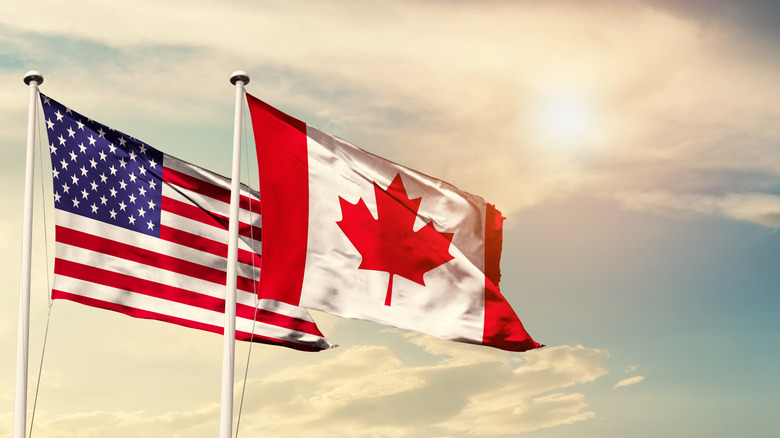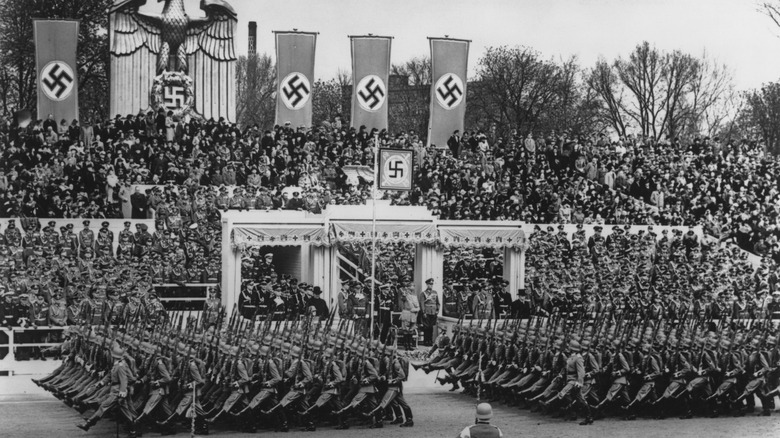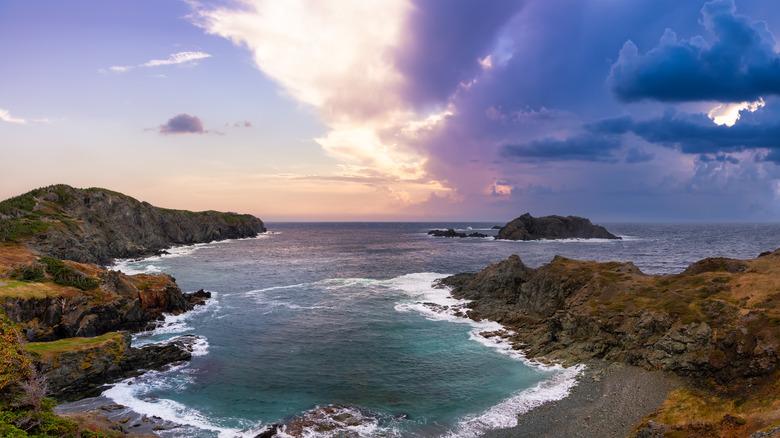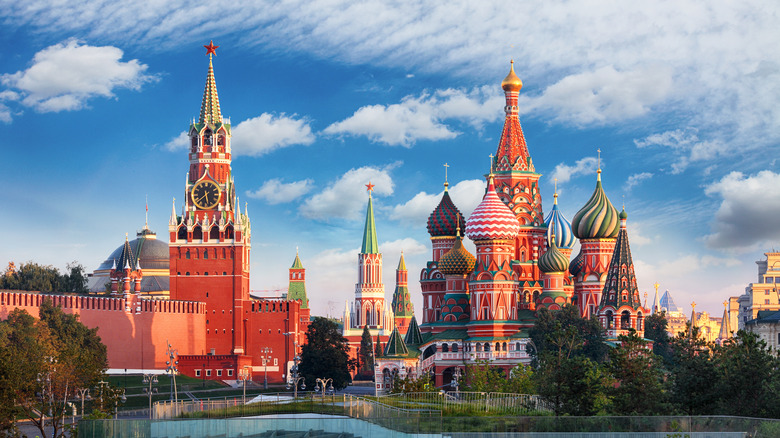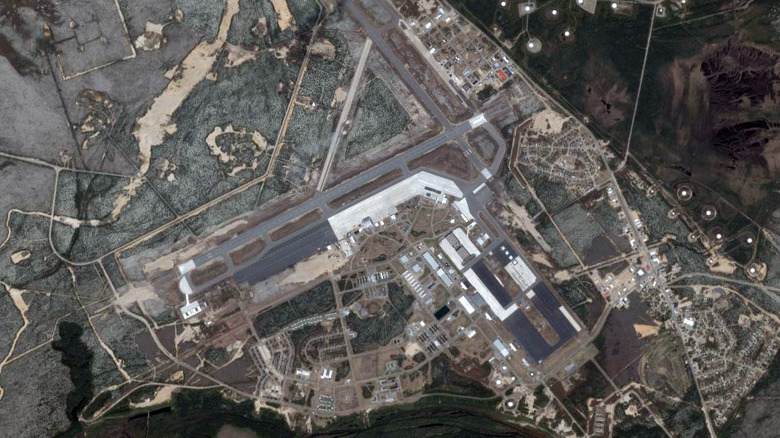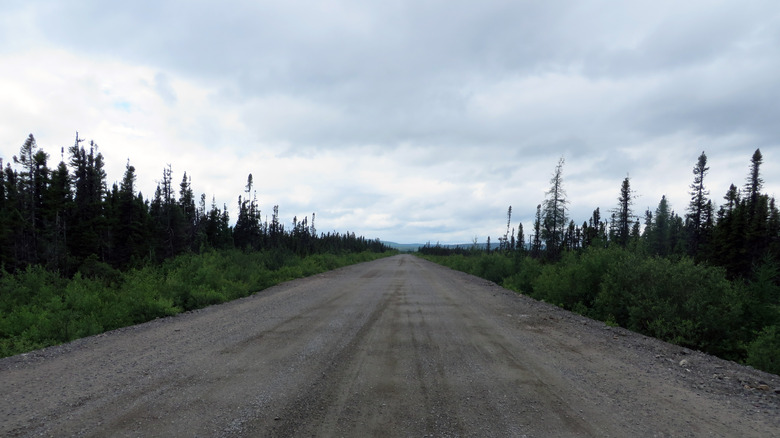The True Story Of The Unexploded Atomic Bomb The US Dropped In Canada
Hi, Canada. You seem nice. That's a nice bear, and a sweet zamboni, and some trees. And ... you know what? We're just going to cut right to the chase. How about we store some bombs in a secret military base in "The Goose" in Labrador and Newfoundland in case the Nazis attack? We'll even toss in a not-at-all-weirdly-named town called "Happy Valley" right on the base to throw people off the scent. And — bonus — if we accidentally drop some non-plutonium-infused atomic bombs on you, we promise not to talk about it for, let's say, half a century? Signed: Your highly armed neighbors to the south, America. (P.S.: Thank you in advance for Ryan Reynolds.)
Yes, there's a lot to unpack in that fictionalized, but still basically true, memorandum between governments. Like many stories of destruction, this one goes back to World War II (thanks, Adolf). As Canada's History explains, U.S. President Franklin Delano Roosevelt and Canadian Prime Minister William Lyon Mackenzie King signed an agreement in 1940 after Nazi Germany started its whole "let's fight the world" thing. The basic gist? If we get attacked by the Nazis, the Russians, the Martians, or anyone else, we band together and not die. Cool? Cool. It took until 1958 for this agreement to mature into NORAD – the North American Air Defense Command — a joint, bi-national defense agreement between the U.S. and Canada. Part and parcel of the original 1940 deal? Canada gets to store some bombs in a secret military base.
The Nazi threat abroad
By the time the Nazis invaded Poland in September 1939 and officially launched World War II, the world had already noticed that something was off in Germany. The stage for World War II had been set following Germany's humiliating defeat in World War I in 1918. As the "stab-in-the-back" myth arose in post-World War I Germany — claiming that someone from within had sabotaged the nation and led to its 7 million dead (via the Anne Frank House and Facing History, respectively) — the National Socialist German Worker's Party rose to fill a power vacuum and give the nation a renewed, murderous identity (via History).
The invasion of Poland was planned, of course, to lure Great Britain and France — who had vowed to protect Poland — into the milieu. The attack also came on the heels of Germany signing a worrying nonaggression pact with Soviet Russia, as History explains. So when Germany attacked Poland, so did Russia, and when Great Britain and France retaliated, Germany declared war on them, too. By June 1940, less than a year after the war began, Paris had fallen.
Meanwhile, across the Atlantic Ocean, the United States and Canada watched and grew understandably nervous. Their allies, Great Britain and France, were failing. Even though it took until December 1941 for the United States to enter the war — after Japan bombed Pearl Harbor — the U.S. and Canada put plans into motion in 1940 to protect the North American continent.
Labrador's strategically ideal location
At first glance, Newfoundland might not seem like the ideal place for a military base, but there was some sound reasoning behind it. At the time, Newfoundland — the island part of Canada's greater "Newfoundland and Labrador" province — was still a colony of Great Britain; it officially joined Canada in 1949, as Heritage explains. This provided a useful "in" for the U.S. to tacitly join World War II from a distance.
In 1940, the U.S. agreed to lease land from Great Britain in both Newfoundland and the Caribbean and to use the locations to build warships to aid in Great Britain's war efforts. But because Newfoundland was still under Canadian jurisdiction, the deal necessitated an agreement with U.S. President Franklin Roosevelt and Canadian Prime Minister William Lyon Mackenzie King. And so, the nascent NORAD was forged.
The first of these bases was at Gander in Newfoundland along the Atlantic Ocean, as Canada's History describes. Gander, though, couldn't keep up with the growing war effort, so Canada leased a second base at Goose Bay for the U.S., Canada, and Great Britain to use. Goose Bay is located in Labrador a bit further north from Gander at an ideal location able to defend across the Atlantic and against Russia. By 1942 there were 5,000 combined U.S., Canadian, and British troops at Goose Bay, and over 3,000 construction workers. By the end of World War II, 24,000 aircraft had passed through its airport headed for Great Britain (via Canada's History).
Shoring up against Russia
As we all thankfully know, Nazi Germany officially lost World War II in 1945. As History describes, Germany and Russia came to an agreement at the Potsdam Conference about how to round out the war, which included carving up Germany into territories controlled by the U.S., Great Britain, France, and Russia. Japan, however, refused to accept the terms of the conference. And so we come to the infamous atomic bombings of Hiroshima (using the "Little Boy" bomb) and Nagasaki (using the "Fat Man" bomb), dropped three days apart and killing 200,000 people instantly (as the Atomic Archive states).
World War II cooled off into the chill of the American-Russian Cold War, which lasted until the Soviet Union collapsed in 1991. In light of the ever-present Soviet threat, Goose Bay lost none of its strategic relevance. After U.S. President Harry Truman took office, he met with Canadian Prime Minister William Lyon Mackenzie King in 1946 to ensure that U.S. troops kept getting funneled into the base. As Canada's History discusses, the Berlin Blockage of 1948 proved the usefulness of Goose Bay as a supply route, and Soviet nuclear testing the following year in 1949 only heightened this usefulness.
When Newfoundland and Labrador officially joined Canada that year, it reduced the strain on relations between the U.S., Canada, and Great Britain. Even before then, though, Canada had opened a Royal Canadian Air Force (RCAF) training center on the base. They'd also, surprisingly so, opened up Goose Bay for commercial, civilian flights.
Dropped without a core
And so we come to the accidentally dropped bomb shenanigans of 1950. After all of the international cooperation to make Goose Bay a success, the usefulness of the base during World War II and the following Cold War, as well as the opening up of Goose Bay to commercial flights, it only took one, single, ridiculous slip-up to nearly ruin American-Canadian relations forever. Canada's History describes the night in question. The Korean War had broken out in 1950, and the U.S. Strategic Air Command (SAC) — a now-defunct branch of the United States Department of Defense (DoD) — approached Canadian Prime Minister Louis St. Laurent with a proposition. They wanted to deploy eleven "special weapons" — atomic bombs — to Goose Bay for a six-week experimental period.
On November 10, 1950, a squadron of B-50 bombers set off from Goose Bay to Arizona. About 100 miles (160 kilometers) south of Quebec, two of one of the aircraft's engines malfunctioned. Following protocol, the crew dropped their cargo, which included a 10,000-pound Mark IV atomic bomb modeled after the Fat Man bomb dropped over Nagasaki. The only saving grace? The bomb didn't have a plutonium core. And yet, the regular ordinance in the bomb went off, and 760 meters in the sky (less than half a mile), the bomb exploded over a residential area along the St. Lawrence River.
Needless to say, the Canadian government was not happy. The cover story for the whole fiasco lasted nearly 50 years.
An uncannily happy valley
We admit that the "accidental dropped bomb" tale rings a bit odd. Transporting atomic bombs to Goose Island for experiments, then carrying one of those bombs back on an airplane that happened to malfunction according to an engine failure that necessitated jettisoning cargo that happened to include an un-cored atomic bomb? Bear in mind that the bomb exploded in the sky just like Fat Man did over Nagasaki, as the Nagasaki National Peace Memorial Hall explains. Atomic weapons contain conventional explosives that start the atomic detonation, as Live Science explains — it's only those explosives that went off over the St. Lawrence River back in 1950.
And yet, believe it or not, that was not the only time that the U.S. apparently flubbed the transportation of the Earth's most deadliest weapon, so maybe the whole Goose Bay bungle is believable. 1958 alone marked eight — eight — nuclear accidents, as KBPS explains. A bomb accidentally fell on Florence, South Carolina, but didn't go off; the crater is currently a tourist attraction. In 1961, a Marx VI accidentally fell on Goldsboro, North Carolina, but also didn't go off; it was 260 times more powerful than the bomb that fell on Hiroshima. More bombs accidentally fell over the ocean, two over Spain (via Ripley's), another over Arkansas, and more.
At present, Goose Bay, i.e., "The Goose," was turned over to Canada in 1967, as the Strategic Air Command says. An 8,000-person town, Happy Valley, has sprouted up nearby.
